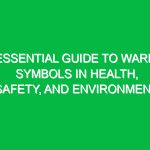Introduction
In the realm of Health, Safety, and Environment (HSE), warning symbols play a crucial role in conveying vital information about potential hazards. These symbols are designed to communicate risks quickly and effectively, allowing individuals to make informed decisions to protect themselves and others. In an increasingly complex world, where safety protocols are paramount, understanding warning symbols becomes essential. This article aims to provide a comprehensive exploration of these symbols, their significance, and how they contribute to safer workplaces and environments.
The Importance of Warning Symbols in HSE
Warning symbols serve as visual cues that alert individuals to existing dangers. They transcend language barriers, making them universally understood regardless of nationality or literacy level. In industries such as construction, manufacturing, and chemical operations, where risks are prevalent, warning symbols act as reminders of necessary precautions. By integrating these symbols into safety training and workplace practices, organizations can foster a culture of safety and awareness.
Understanding warning symbols is not merely about recognition; it involves comprehending the associated risks and the actions required to mitigate them. A well-placed warning symbol can prevent accidents and injuries, saving lives and reducing costs related to workplace incidents. Moreover, they are integral to compliance with regulations and standards, which further underscores their significance in the HSE landscape.
Key Warning Symbols in HSE
Warning symbols can be categorized based on the type of hazards they represent. Below, we explore some of the most critical warning symbols relevant to HSE:
1. Chemical Hazard Symbols
Chemical hazard symbols indicate the presence of substances that can cause harm to health or the environment. The Globally Harmonized System of Classification and Labelling of Chemicals (GHS) has standardized many of these symbols. Some common chemical hazard symbols include:
- Skull and Crossbones: Indicates toxic substances that can cause death or serious health effects.
- Flame: Signifies flammable materials that can ignite easily.
- Corrosion: Represents corrosive materials that can damage skin and materials.
- Exclamation Mark: Alerts to hazards that may cause less severe health effects or damage the ozone layer.
Understanding these symbols is critical, especially for workers handling chemicals. For instance, a worker in a laboratory must recognize the skull and crossbones symbol to take appropriate precautions when working with a toxic reagent.
2. Physical Hazard Symbols
Physical hazards refer to risks associated with the physical environment or equipment. Common physical hazard symbols include:
- Electrical Hazard: Indicates the potential for electric shock or electrocution.
- Radiation: Warns of radiation exposure that can cause serious health risks.
- Falling Objects: Alerts to the risk of objects falling from heights, common in construction sites.
These symbols are vital in environments where machinery and equipment are in use. For instance, recognizing the electrical hazard symbol can prompt workers to follow lockout/tagout procedures to prevent accidental electrocution during maintenance.
3. Biological Hazard Symbols
Biological hazards are related to living organisms that can cause health risks. The biological hazard symbol, often depicted as a three-part design resembling a trefoil, indicates the presence of infectious agents. This symbol is crucial in healthcare settings and laboratories where exposure to pathogens is possible.
Workers in these environments must be trained to understand the significance of this symbol, as it necessitates the use of personal protective equipment (PPE) and adherence to safety protocols to prevent exposure.
4. Environmental Hazard Symbols
Environmental hazard symbols indicate risks to the environment. These symbols can range from those warning about pollutants to symbols indicating the presence of hazardous waste. The significance of these symbols extends beyond immediate health risks; they also highlight the importance of environmental protection.
For instance, the symbol representing hazardous waste is crucial for ensuring that such materials are disposed of properly, thereby preventing contamination of soil and water sources.
Real-Life Applications of Warning Symbols
Understanding warning symbols is not just theoretical; it has practical implications in everyday scenarios. Consider a construction site where various hazards are present. Each piece of equipment may have warning symbols indicating specific risks. For example, a crane may display a symbol for falling objects, reminding workers to wear hard hats.
In a chemical manufacturing plant, safety data sheets (SDS) are often accompanied by symbols that indicate the hazards of various chemicals. Workers are trained to interpret these symbols to handle substances safely. An incident in a chemical plant, where a worker failed to recognize the flammable symbol, resulted in a significant fire, underscoring the importance of proper training and awareness.
Another example is in healthcare, where biological hazard symbols are critical. During the recent pandemic, healthcare workers had to navigate numerous hazards while treating patients. Proper understanding of the biological hazard symbol allowed them to implement appropriate safety measures, ultimately reducing the risk of exposure to infectious diseases.
Regulations and Standards Governing Warning Symbols
Warning symbols in the HSE domain are governed by various regulations and standards that ensure consistency and safety. The Occupational Safety and Health Administration (OSHA) in the United States, for instance, mandates the use of specific hazard symbols in workplaces to protect employees. Similarly, the European Union has established directives that require the use of standardized symbols to inform workers about hazards associated with chemicals and other substances.
In addition to OSHA and EU regulations, the GHS provides a framework for classifying and labeling chemicals. This international standard has been adopted by many countries, facilitating global trade and ensuring that workers worldwide can recognize and understand hazard symbols.
Compliance with these regulations not only enhances workplace safety but also protects organizations from legal liabilities. Failure to adhere to standards can result in fines, penalties, and increased insurance costs, making it imperative for companies to integrate these symbols into their safety protocols.
Best Practices for Implementing Warning Symbols
To maximize the effectiveness of warning symbols, organizations should adopt several best practices:
- Training: Regularly train employees on the meaning of warning symbols and appropriate response actions.
- Visibility: Ensure that warning symbols are prominently displayed in areas where hazards exist.
- Regular Audits: Conduct audits to ensure that warning symbols remain relevant and that employees understand them.
- Feedback Mechanism: Encourage employees to provide feedback on the clarity and visibility of warning symbols.
Implementing these practices can significantly enhance workplace safety and foster a culture of awareness and responsibility among employees.
Conclusion
Warning symbols are more than mere images; they are essential tools in the HSE domain, serving to protect lives and promote safety. By understanding these symbols and their meanings, individuals can navigate potential hazards more effectively, contributing to safer workplaces and environments.
As regulations evolve and industries change, the importance of clear communication through warning symbols will only grow. Organizations must prioritize training and awareness, ensuring that every employee understands the significance of these symbols. By doing so, we not only comply with legal standards but also cultivate a proactive approach to health, safety, and environmental stewardship.
In contemplating the role of warning symbols, consider how they can serve as a foundation for a culture of safety. Engage with your colleagues, share insights, and promote discussions about the importance of these symbols in your workplace. Together, we can foster an environment where safety is everyone’s responsibility.


